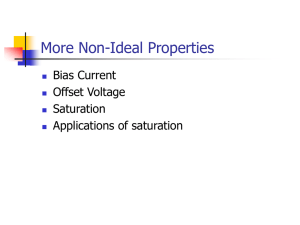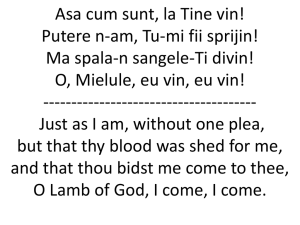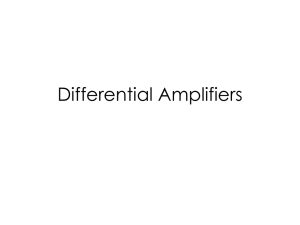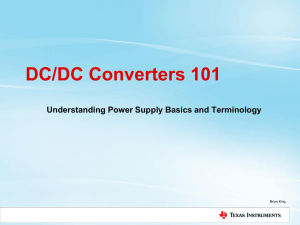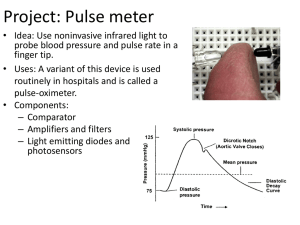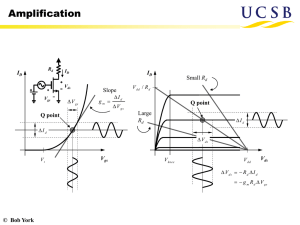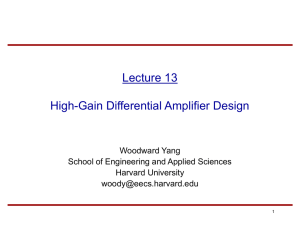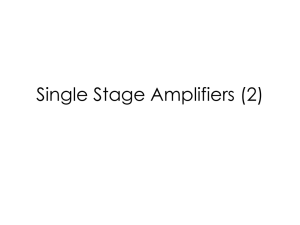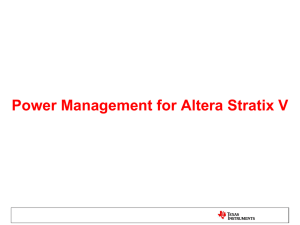Filters
advertisement
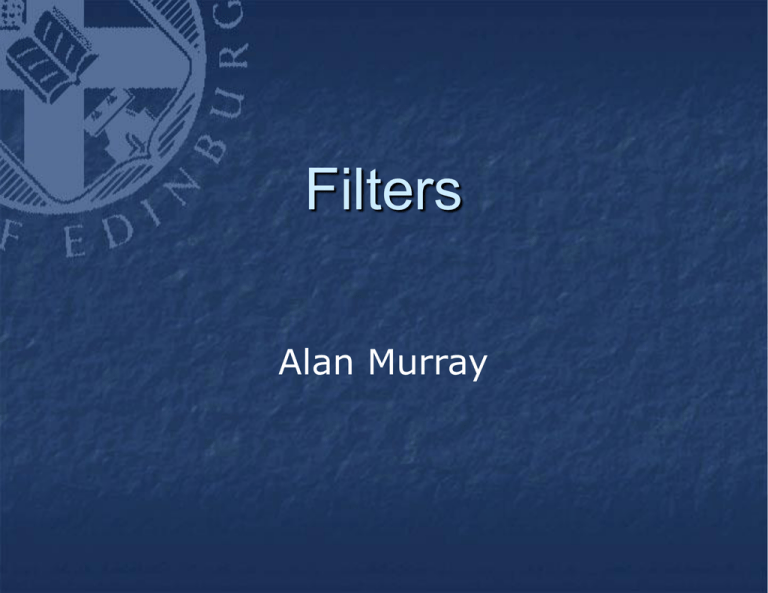
Filters Alan Murray Agenda What is a filter? Filter types (revision from Eng 1) Capacitors and Frequency (revision) Passive (RC) Filters Active filter Alan Murray – University of Edinburgh Filters?? What are they 1kΩ DC+AC 0.1μF Vin 1kΩ - Vout AC only + 1Hz AC only THIS IS AN AMPLIFIER CIRCUIT, WHOSE GAIN VARIES WITH FREQUENCY 10Hz 100Hz1Hz 1kHz -1 IT IS A FILTER! GAIN Alan Murray – University of Edinburgh Frequency of Vin IDEAL HIGH-PASS FILTER Frequency IDEAL BAND-PASS FILTER Frequency BAND-STOP ("NOTCH") FILTER IDEAL Frequency Clickers Alan Murray – University of Edinburgh Vout/Vin Vout/Vin Frequency Vout/Vin IDEAL LOW-PASS FILTER Vout/Vin Vout/Vin Vout/Vin Vout/Vin Vout/Vin Filter Types Vin FILTER CIRCUIT Vout REAL Frequency REAL Frequency REAL Frequency REAL Frequency Voltage and Current (AC) in a Capacitor ω=2πf V = V0 sin(ωt) I Vs V π/2 Animate this slide! “simulation” I = I0cos(wt) = I0sin(ωt+90°) Alan Murray – University of Edinburgh Potential Divider (again!) Vin R' Vout R Vin R R' R Now exchange R' for a capacitor Alan Murray – University of Edinburgh Vout High-Pass RC Filter Vin C Vout Vin R 1 R j C R Alan Murray – University of Edinburgh Vout High-Pass RC Filter Vin C Vout R Capacitor blocks DC, Impedes low frequencies Discharged to 0V Vin C Vout Capacitor passes AC, Passes high frequencies R Alan Murray – University of Edinburgh High-Pass RC Filter High Frequency, ω∞ Vin C Vout Vin R 1 R 0 j C R Alan Murray – University of Edinburgh Vout =Vin High-Pass RC Filter Low Frequency, ω0 Vin C Vout Vin R 1 R ∞ j C R Alan Murray – University of Edinburgh Vout =0 High-Pass RC Filter |Gain| 1 (1/ √2) 0 Phase ωc = 1/(RC) Frequency ω>ωc Vin 90° C Vout |Gain| = 1, Phase = 0° R 45° 0° ω<ωc Vin C Vout R ωc is the “Critical frequency”, 1/RC, where Gain = 1/√2 and Phase difference = 45° = π/4 ω=ωc Vin C R Alan Murray – University of Edinburgh |Gain|≈ 0, Phase = 90° Vout |Gain| = 1/√2, Phase = 45° Low-Pass RC Filter Gain Vin R Vout 1 1 ωR C 2 , Phase tan 1 ω RC C |Gain| Clickers? Frequency ωc = 1/RC Phase 0° -45° -90° Alan Murray – University of Edinburgh This is a "Passive Filter" It has no power supplies No transistors, diodes etc. Gain is always ≤ 1 Output load becomes part of the circuit .. Vin R C I Vout Rload i.e. - this will not work as designed! Alan Murray – University of Edinburgh Inverting Circuit - Revision Gain = - R r R Vin r + Vout Add a capacitor ... Alan Murray – University of Edinburgh Inverting Circuit - Revision X C Gain = - R r Gain = - R//C r R Vin r + Vout What is R//C ... R in parallel with C? Alan Murray – University of Edinburgh Handwaving analysis, Active Filter ω → ∞ C ZC = 1/(jωC), ω → ∞, ZC → 0 Vinv = Vnoninv = 0 = Vout Blocks high-frequency, therefore low-pass? Vin R r + Alan Murray – University of Edinburgh Vout Handwaving analysis, Active Filter ω → 0 X C ZC = 1/(jωC), ω → 0, ZC → ∞ Simple inverting op-amp circuit. Passes low frequencies. Definitely low-pass. Vin R r + Alan Murray – University of Edinburgh Vout Active Filter Characteristics Current into load comes from Op-Amp J –NOT from source Filter is "buffered" from the load J Filter can have gain>1 J Needs power L Alan Murray – University of Edinburgh Applications? Passive • Smoothing mains power supply • Loudspeaker "crossover" circuit Active • Amplifier tone controls to woofer and tweeter! Alan Murray – University of Edinburgh High-pass Low-pass = treble = bass Summary Why, what and how filters are made. Why Passive (RC) Filters work Why Active (RC) Filters work and are useful Alan Murray – University of Edinburgh

